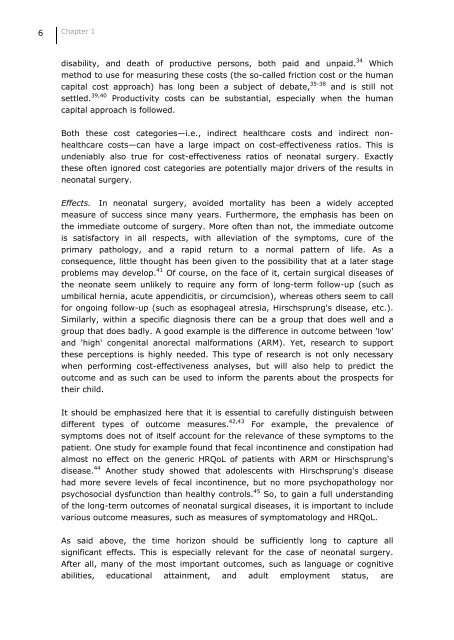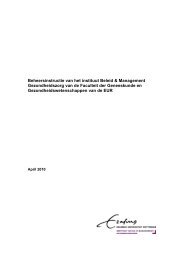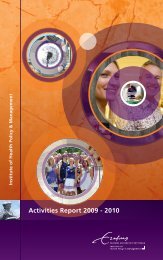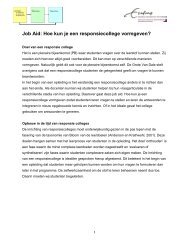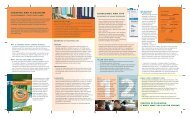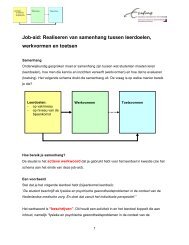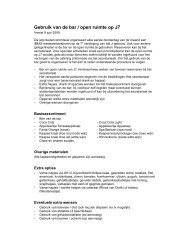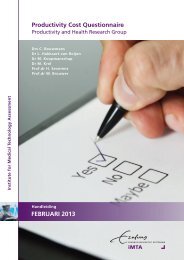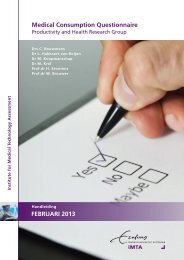6Chapter 1disability, and death of productive persons, both paid and unpaid. 34 Whichmethod to use for measuring these costs (the so-called friction cost or the humancapital cost approach) has long been a subject of debate, 35-38 and is still notsettled. 39,40 Productivity costs can be substantial, especially when the humancapital approach is followed.Both these cost categories—i.e., indirect healthcare costs and indirect nonhealthcarecosts—can have a large impact on cost-effectiveness ratios. This isundeniably also true for cost-effectiveness ratios of neonatal surgery. Exactlythese often ignored cost categories are potentially major drivers of the results inneonatal surgery.Effects. In neonatal surgery, avoided mortality has been a widely acceptedmeasure of success since many years. Furthermore, the emphasis has been onthe immediate outcome of surgery. More often than not, the immediate outcomeis satisfactory in all respects, with alleviation of the symptoms, cure of theprimary pathology, and a rapid return to a normal pattern of life. As aconsequence, little thought has been given to the possibility that at a later stageproblems may develop. 41 Of course, on the face of it, certain surgical diseases ofthe neonate seem unlikely to require any form of long-term follow-up (such asumbilical hernia, acute appendicitis, or circumcision), whereas others seem to callfor ongoing follow-up (such as esophageal atresia, Hirschsprung's disease, etc.).Similarly, within a specific diagnosis there can be a group that does well and agroup that does badly. A good example is the difference in outcome between 'low'and 'high' congenital anorectal malformations (ARM). Yet, research to supportthese perceptions is highly needed. This type of research is not only necessarywhen performing cost-effectiveness analyses, but will also help to predict theoutcome and as such can be used to inform the parents about the prospects fortheir child.It should be emphasized here that it is essential to carefully distinguish betweendifferent types of outcome measures. 42,43 For example, the prevalence ofsymptoms does not of itself account for the relevance of these symptoms to thepatient. One study for example found that fecal incontinence and constipation hadalmost no effect on the generic HRQoL of patients with ARM or Hirschsprung'sdisease. 44 Another study showed that adolescents with Hirschsprung's diseasehad more severe levels of fecal incontinence, but no more psychopathology norpsychosocial dysfunction than healthy controls. 45 So, to gain a full understandingof the long-term outcomes of neonatal surgical diseases, it is important to includevarious outcome measures, such as measures of symptomatology and HRQoL.As said above, the time horizon should be sufficiently long to capture allsignificant effects. This is especially relevant for the case of neonatal surgery.After all, many of the most important outcomes, such as language or cognitiveabilities, educational attainment, and adult employment status, are
Introduction 7developmentally programmed to occur years if not decades after theintervention. 46 To take just one example, it requires a follow-up of more than twodecades to see whether early surgery for undescended testes has a favorableeffect on fertility.The position of the parents. A consequence of taking a societal perspective isthat the position of the parents should not be ignored in cost-effectivenessstudies of neonatal surgery. Major health problems in infants affect the wholefamily. In a small-scale study from Norway for example, 59% of the parents ofchildren with 'low' ARM and 23% of the parents of children with Hirschsprung'sdisease reported that their child's malformation had a negative influence on theirmarital relationship and family life. Fifty-three percent of the parents of childrenwith a 'low' ARM recalled that they became isolated from their family, friends, andsocial activities. 47Again it is important to precisely distinguish between different outcomemeasures. To assess the effects of providing so-called 'informal care' to childrensuffering from congenital anomalies, there are various options, such as measuringgeneral effects on the caregivers' wellbeing, marital and life satisfaction, broadlydefinedquality of life, burden of informal care, or HRQoL. Earlier studies inchildren with a chronic illness or disability mainly focused on the burden thatinformal caregiving may cause. Hassink et al. for example investigated stress inparents of children with ARM and found that especially the parents of older boyswho were incontinent for feces experienced stress when caring for their child. 48Such studies also demonstrated that impacts on the family differ according to thetype of condition. 49,50 Yet, present understanding of the effects of caregiving onparents' multidimensional HRQoL is still rudimentary in neonatal surgery. It isexactly this outcome measure however that seems to have great value to informcost-effectiveness analysis. HRQoL represents an overall outcome measure,comprises a valuation of some type, may be measured by using instrumentssimilar to the ones used to assess patients' HRQoL, and closely matches the maingoal of health care (i.e., to preserve or restore health). Despite these appealingfeatures, the full potential and limitations of the HRQoL outcome measure inparents are not yet fully understood.Like the effects on the parents, the costs of providing informal care are presentlyoften ignored in economic evaluations. 33,51 Yet, it is increasingly beingacknowledged that a child with a chronic health condition requires additionalcaregiver time. 52 Studies in parents of children with atopic dermatitis, childrenwith cystic fibrosis, and gastrostomy-dependent children showed that caregivingtakes up significant amounts of time, reducing the time available for otheractivities such as work or recreation, and that it may be associated with high outof-pocketexpenses. 53-55 However, evidence in neonatal surgery is largely lacking.Obviously, the costs that fall to the caregivers, such as transportation costs
- Page 3: COST-EFFECTIVENESS OF NEONATAL SURG
- Page 6 and 7: DOCTORAL COMMITTEEPromotors:Prof.dr
- Page 9 and 10: PUBLICATIONSChapters 2 to 7 are bas
- Page 11: 6ChapterINFORMAL CARE FOR CHILDREN
- Page 14 and 15: 2Chapter 11.1 BACKGROUND AND MOTIVA
- Page 16 and 17: 4Chapter 1provides a good overview
- Page 21: Introduction 9particular equity pri
- Page 25 and 26: Introduction 1320. Oostenbrink JB,
- Page 27 and 28: Introduction 1554. Heyman MB, Harma
- Page 29 and 30: THE COST-EFFECTIVENESS OFTREATMENT
- Page 31: Cost-Effectiveness of Treatment for
- Page 35 and 36: Cost-Effectiveness of Treatment for
- Page 37 and 38: Cost-Effectiveness of Treatment for
- Page 39 and 40: Cost-Effectiveness of Treatment for
- Page 41 and 42: Cost-Effectiveness of Treatment for
- Page 43 and 44: Cost-Effectiveness of Treatment for
- Page 45: Cost-Effectiveness of Treatment for
- Page 48 and 49: 36Chapter 3ABSTRACTBackground/Purpo
- Page 50 and 51: 38Chapter 33.2 MATERIALS AND METHOD
- Page 52 and 53: 40Chapter 3child's date of birth) a
- Page 54 and 55: 42Chapter 3diaphragm was closed (Ta
- Page 56 and 57: 44Chapter 3Total costs of treatment
- Page 58 and 59: 46Chapter 3Regarding the treatment
- Page 60 and 61: 48Chapter 3REFERENCES1. Stolk EA, P
- Page 62 and 63: 50Chapter 332. Jaillard S, Pierrat
- Page 64 and 65: 52Chapter 4ABSTRACTAims:To examine
- Page 66 and 67: 54Chapter 4Outcome measuresThe pati
- Page 68 and 69:
56Chapter 4Clearly, the symptoms st
- Page 70 and 71:
58Chapter 4The respondents did not
- Page 72 and 73:
60Chapter 4Table 4.4TAIQOL Scores o
- Page 74 and 75:
62Chapter 44.4 DISCUSSIONIn this pa
- Page 76 and 77:
64Chapter 4ACKNOWLEDGMENTSWe are in
- Page 78 and 79:
66Chapter 418. Coons SJ, Rao S, Kei
- Page 80 and 81:
68Chapter 5ABSTRACTObjective:Extrac
- Page 82 and 83:
70Chapter 5treatment. 26,27 Finally
- Page 84 and 85:
72Chapter 5CostsOnly direct costs w
- Page 86 and 87:
74Chapter 5summarized in Table 5.2.
- Page 88 and 89:
76Chapter 5Table 5.3 Direct Medical
- Page 90 and 91:
78Chapter 5Figure 5.3 illustrates o
- Page 92 and 93:
80Chapter 5severely ill newborns—
- Page 94 and 95:
82Chapter 5REFERENCES1. Bartlett RH
- Page 96 and 97:
84Chapter 533. Meinert CL: Extracor
- Page 98 and 99:
86Chapter 568. Hui TT, Danielson PD
- Page 100 and 101:
88Chapter 6ABSTRACTObjective:To inv
- Page 102 and 103:
90Chapter 6a rule. The health-relat
- Page 104 and 105:
92Chapter 6Regression analysis of h
- Page 106 and 107:
94Chapter 6that caregiving for thei
- Page 108 and 109:
96Chapter 6Table 6.5 CareQol Compar
- Page 110 and 111:
98Chapter 6children with a disabili
- Page 112 and 113:
100Chapter 6This study was of impor
- Page 114 and 115:
102Chapter 618. Poley MJ, Stolk EA,
- Page 116 and 117:
104Chapter 654. Boman KK, Viksten J
- Page 118 and 119:
106Chapter 7ABSTRACTMortality rates
- Page 120 and 121:
108Chapter 77.2 THE RELEVANCE OF CO
- Page 122 and 123:
110Chapter 7In the early 2000s, our
- Page 124 and 125:
112Chapter 7Table 7.1 Economic Eval
- Page 126 and 127:
114Chapter 7More from a policy pers
- Page 128 and 129:
116Chapter 7also expect that life-s
- Page 130 and 131:
118Chapter 7entirely justified, for
- Page 132 and 133:
120Chapter 723. Sydorak RM, Nijagal
- Page 134 and 135:
122Chapter 765. Glaser AW, Davies K
- Page 137 and 138:
GENERAL DISCUSSION:A GUIDED TOURPRO
- Page 139 and 140:
General Discussion: A Guided Tour P
- Page 141 and 142:
General Discussion: A Guided Tour P
- Page 143 and 144:
General Discussion: A Guided Tour P
- Page 145 and 146:
General Discussion: A Guided Tour P
- Page 147 and 148:
General Discussion: A Guided Tour P
- Page 149 and 150:
General Discussion: A Guided Tour P
- Page 151:
General Discussion: A Guided Tour P
- Page 154 and 155:
142GlossaryCharge (or: tariff)A pri
- Page 156 and 157:
144Glossaryefficient one. We are th
- Page 159 and 160:
SUMMARY
- Page 161 and 162:
Summary 149mortality. Finally, it i
- Page 163 and 164:
Summary 151neonatal surgery. It is
- Page 165 and 166:
SAMENVATTING
- Page 167 and 168:
Samenvatting 155zoals directe niet-
- Page 169 and 170:
Samenvatting 157Hoofdstuk 6 gaat ve
- Page 171:
Samenvatting 159vereisen, waarvoor
- Page 174 and 175:
162AcknowledgmentsAlthough I am ind
- Page 176:
About the AuthorBorn in De Meern (N


